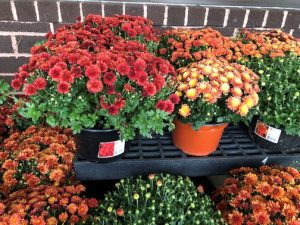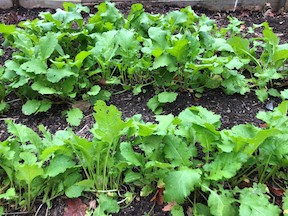Written by Colleen Amster and Arianna Ege, UConn Extension Master Gardener Volunteers

September is a good time for Connecticut gardeners to begin the fall cleanup and assessment process. It is also a good time to shop for trees, shrubs, and bulbs, and prepare for next year’s growing season. Here is a helpful list to get you started:
Annual and herbaceous perennials
- Take note of which annuals did well in your garden this year and decide what plants you would like to add to your beds next spring, and where. It is helpful to take photos of the bare spots that you would like to fill.
- Remove and compost spent annuals. Some annuals like geraniums can be dug up and placed in a cool place to overwinter in containers.
- Some annuals are cold hardy, like pansies, calendula, sweet pea and ornamental kale, and can be planted now.
- Begin to harvest and dry (in paper bags) seeds for herbaceous perennial plants that are ready to be collected by late September like hibiscus syriacus (Rose of Sharon), echinacea (coneflower), rudbeckias (black-eyed susans), baptisia (false indigo) and some helianthus (sunflowers), just to name a few. Store seeds, once they are dry, in containers or bags in a cool dry location. Some coneflower seed heads, like echinacea, will need to be shaken in a container to separate the seeds from the chaff. Seeds can be started outdoors later in the fall or, for better results, inside in potting medium in the spring. Some will need to be refrigerated and stratified.
- As herbaceous perennials turn brown, begin cutting back plants from 4-8” from the ground, depending on the plant. Some fibrous herbaceous perennials do best when they are divided every few years, including echinacea, hostas, and peonies.
- Take note of any perennials that have been impacted by powdery mildew or fungal diseases. Look for fungal problems on leaves and remove and dispose of any diseased plant parts. This is a good time to research and implement treatments for plants that have been impacted by botrytis, or root rot, or other diseases over the last growing season.
- It is also a great time to buy discounted plants that transplant well in fall. Many local plant trusts have sales in September and some will sell grouping of pollinator plants. Planting in fall allows root systems extra time to develop.
Bulbs, tubers, rhizomes, and corms
- Decide what bulbs you would like to add to your garden beds and buy from a reputable source.
- Before purchasing bulbs, check for disease or damage, such as rot, cuts, or bruises and do not buy bulbs that are soft or moldy. Make sure bulbs are firm and have a protective papery skin. Purchase hardy bulbs in August-September and plant the bulbs as soon as possible. Plant from mid-September to mid-October so the bulbs can grow roots before the ground freezes.
- Store bulbs in a dry place away from direct sunlight until you are ready to plant them.
- A special note about garlic: Garlic is especially beneficial in the garden. It is nutritious, easy to grow, repels pests and wildlife, and is a good pollinator plant if some is allowed to bloom. It comes in three varieties, hardenck, softneck, and elephant. If you are planting garlic next month, cloves should be purchased from a reputable supplier or local garden center. Garlic bulbs sold in the grocery store are mainly grown in China and California and may have diseases, nematodes, or viruses that can impact your soil.
Vegetable and herbs

- Maintain good sanitation in your vegetable gardens, pruning and removing diseased leaves, weeds, and any plants that are no longer producing viable fruit to reduce insect and disease issues, and staking plants like tomatoes to keep them off the ground.
- Make room for cool weather greens like spinach, lettuces, radishes, collard greens, swiss chard, kale, cabbage, kohlrabi, and mustard. Brussel sprouts can still be started now, as well as carrots and rutabagas. Check out this planting calendar for best dates to plant in your zip code: https://www.almanac.com/gardening/planting-calendar/zipcode/06070/date.
- Harvest veggies as they ripen. Harvest and dry herbs that are beginning to get leggy or that have begun to flower or bolt.
- It is a good time to save heirloom seeds for next season, including tomatoes. Fun fact: any tomatoes that haven’t ripened on the vine by the first forecasted frost can be harvested green and stored indoors until they begin to ripen! See this article for details: https://publications.extension.uconn.edu/2014/10/27/is-your-garden-bursting-with-fall-tomatoes/.
- You can take herb cuttings at this time to start herbs like mint and oregano indoors in a sunny window.
- Protecting your fall vegetables and flowers with row covers will give you extra growing time in the season and protect tender plants from sudden temperature changes.
Trees and shrubs
- Focus on removing deadwood and deadheading flowers after they bloom. Don’t prune too heavily, because new growth will not have time to harden off before winter and will be more susceptible to frost damage.
- It is a good time to plant trees and shrubs, many of which are on sale this time of year!
- Continue harvesting seasonal fruits.
- Sanitize the area around each plant by removing fallen fruit and plant debris to prevent the spread of disease and pests.
- Never add a heavy application of fertilizer to perennials or trees in the late fall as it will encourage new growth and plants can be injured by an early frost.
Lawns
- Mow grass below 3” now that temperatures are dropping to reduce matting and fungal issues.
- If your lawn is compacted, consider de-thatching and aerating.
- Remove weeds and dead grass to expose soil and apply fertilizer. Now is the best time of year to plant grass seed and fill those bare patches in your lawn!
Soil and pests
- Make plans to add mulch around plants that will need extra protection during the winter months and order a delivery of mulch if that is more economical than buying it in bags. Evergreens and other perennials will need a protective layer of mulch before the first frost. Remember to ask your supplier if they sell certified compost and mulch–and heat their products to at least 104 degrees to kill invasive earthworm cocoons and other pests.
- All plants should be quarantined and observed before planting and some invasive pest research groups are recommending that all new plants be thoroughly rinsed and planted with bare roots.
- Prepare your leaf collection bin and compost bin for cool weather.
- Check for insect pests including the spotted lanternfly (and report any you find) and invasive earthworms.
- Apply deer repellent or plan for netting trees and perennials that deer tend to browse, including arborvitaes and yews.
- Continue to weed garden beds and maintain good sanitation.
- Many Connecticut gardeners are reporting infestations of the invasive Asian jumping or snake worm. Wood ash is always a beneficial fall amendment but has the added benefit of repelling these worms; diatomaceous earth or biochar may also be used to combat them.
- Last, collect soil samples to be tested while the soil is still easily workable so you can plan soil amendments accordingly: https://soiltest.uconn.edu/sampling.php
References and further reading
Perennials: http://www.ladybug.uconn.edu/FactSheets/perennials.php
Bulbs, tubers, rhizomes, corms: https://web.extension.illinois.edu/bulbs/planting.cfm
Seed saving: https://homegarden.cahnr.uconn.edu/seed-starting/
Flowering sequence of different types of bulbs: https://web.extension.illinois.edu/bulbs/selection.cfm
Garlic: http://www.ladybug.uconn.edu/index_306_3102396391.pdf http://www.ladybug.uconn.edu/Articles_28_731441880.pdf
Tomatoes: http://www.ladybug.uconn.edu/FactSheets/tomatoes.php
Saving seeds: http://www.ladybug.uconn.edu/Articles_25_1925738656.pdf
Invasive earthworms: https://ag.umass.edu/sites/ag.umass.edu/files/pdf-doc-ppt/kostromytska_invasive_earthworms_ppt.pdf
https://extension.psu.edu/look-out-for-jumping-earthworms
September gardening: http://www.ladybug.uconn.edu/FactSheets/gardening-tips-september_15_1424196800.pdf
Fall gardening: https://publications.extension.uconn.edu/tag/fall-gardening/
Tree, shrub, and perennial planting and aftercare: https://clear.uconn.edu/projects/crlg/documents/f3.pdf
Fall lawn care: http://www.ladybug.uconn.edu/Articles_69_3249872767.pdf